While I recognize that Everdell Silverfrost is another edge of the map, it would seem that a new world altogether has dropped like a blanket of frozen, wintry precipitation.
The first signal of change is the artwork of Lukas Siegmon, who has worked alongside some top notch designers in the last few years. From Wolfgang Kramer (Intarsia, The Princes of Florence) to Helge Ostertag (Age of Innovation) to Uwe Rosenberg (Hallertau, Applejack, Planet Nubo) and Stefan Feld (Vienna), Siegmon has utilized his talents to bring several worlds to life. With Silverfrost, he has entered a world of critters and constructions lovingly brought to life in past iterations by Andrew Bosley and Jacqui Davis, albeit with a style that is ever so slightly less cute and more… weathered. Pardon the puns, but in this case the snowshoe fits.
Looming above the board, however, is the second major change (provided you have the Collector’s Edition, of course). The massive 3D mountain is topped with a bowl of snow— mocking, relentless snow. But before I get ahead of myself, let me start at the beginning.
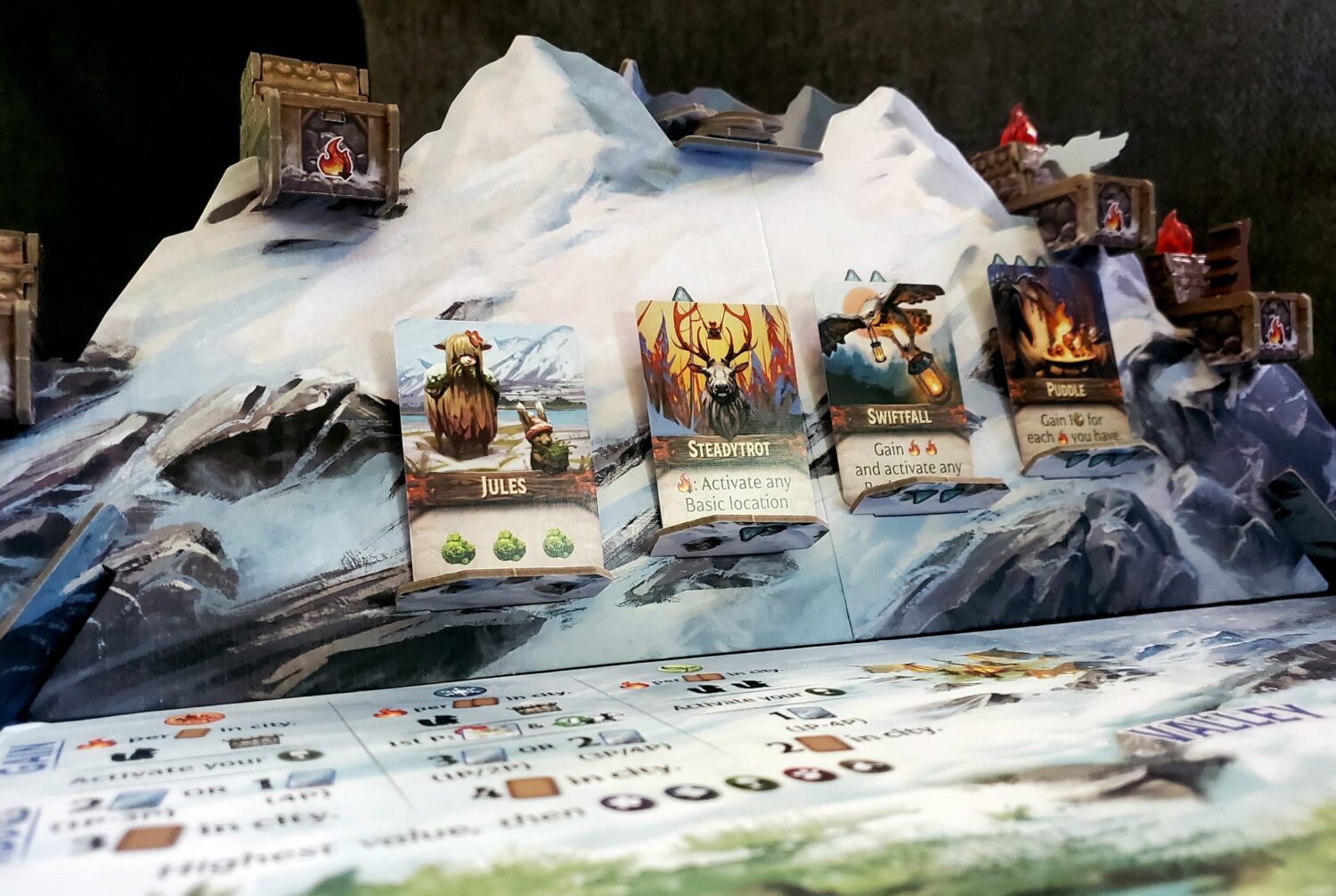
Everdell, alive and well
Silverfrost remains true to the Everdell form, inviting players to visit worker placement locations to collect four resources— birch, moss, copper, and acorns. The core aspect of the game, collecting resources to spend playing cards into a growing city, has not changed. As was the case with Farshore, Silverfrost translates a number of cards in recognizable ways: the Cellar clearly replaces the Farm, the Mossery the Resin Refinery, etc. It is this base system that has made Everdell wonderful, and here it remains intact as players move through four seasons to build a city of 15 cards.
For those who have played the base game of Everdell with the Spirecrest expansion, there are also notable resemblances, but with a streamlined twist. The imposing mountain holds display spaces for four big critter cards. Players can visit beacon locations on the mountain to summon these critters for a bit of momentary help, most often in the form of a generous shower of resources. These locations also come with an increasing quantity of coins/point tokens, adding a different incentive when deciding which critter to call upon. The beacons are perhaps the easiest place to speak of Silverfrost’s new resource— fire.
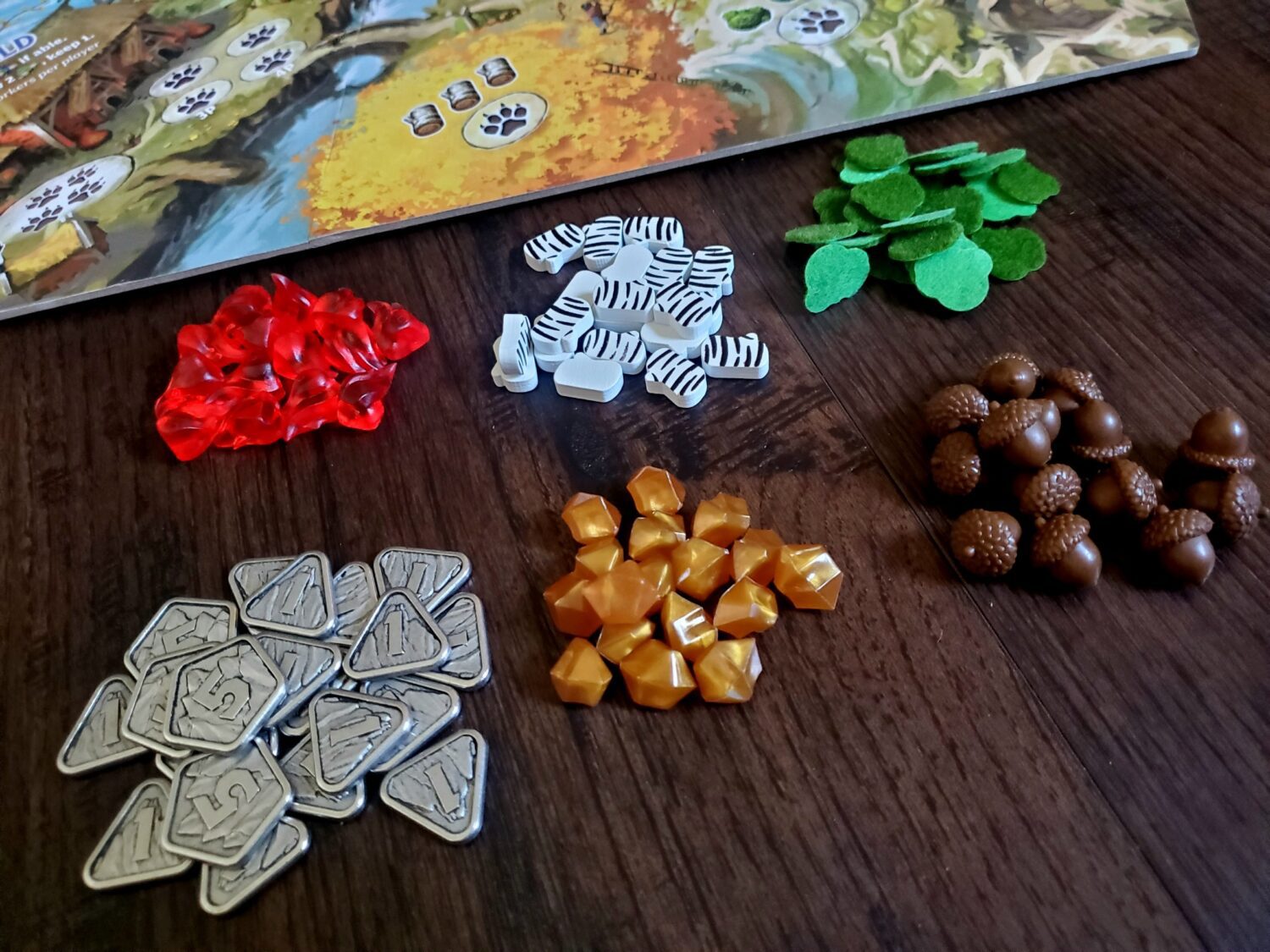
Fire is everywhere in this new map. Some locations, like the beacons, require fire to activate. Others demand fire for being late to the party (so to speak) as secondary worker locations that allow for multiple visitors might require a flame as payment for not being first. In the player city, chimney tokens are used on certain construction cards to play corresponding critter cards for free, but these, too, cost fire to activate. Fire itself is acquired via one dedicated location on the board, via certain big critters on the mountain, and at the turn of each season. But no matter where it comes from, there never seems to be enough of it in this brutal endeavor.
Brutality
Wait a minute, Bob— brutality!? You heard me. Taking another cue from Spirecrest, Silverfrost has incorporated weather as a hindrance in the form of snow. There may be fire all over the map, but it is slightly outpaced by the amount of snow that falls. As each player prepares for season, which is the phase in Everdell where players recollect their placed workers and unleash a series of effects, snow falls all over everyone’s business.
Players draw a number of cards based on the player count and place a snow token in the location depicted. This snow might fall on the resource locations, on the mountain beacons, or on the cards in the Valley. Once snow has fallen, the locations or cards require a payment of fire to liberate once again for use. The good news is that each individual spot on the board appears but once in the deck, so no particular location will be hit twice. But it’s not as if the snow only falls on the generic area. Each individual spot, each individual Valley card, is in the deck somewhere. Not a parcel of Silverfrost’s land is safe— especially player cities.

In addition to the board, players must also drop snow on their played cards at the turn of season. All told, as many as nine cards will be covered (depending on the speed at which each player’s city grows) at some point during the game. They are covered first according to value, then according to suit. In this way, the game’s best and most useful cards are targeted at least once during play.
Oh, and did I mention that from the moment any player prepares for Winter, the game’s third season, the cost to remove snow increases from one to two fire tokens? And did I also mention that beginning with winter, players receive only one fire per two cards instead of the precious 1:1 ratio from the first preparation? In this way, the winter season introduces a level of harshness to Everdell unparalleled in any previous title. Players are constantly fighting the snow, calculating the use of precious fire tokens from start to finish.
Adding to the brutality, when a card is covered by snow, it takes up a spot but is otherwise crippled. If it provides a location (red cards), that location is closed. If it provides an ability (blue), it is null and void. If it provides wicked scoring possibilities (purple), they are canceled unless the snow is removed. All that hard work of building is under threat. And if cards work together synergistically (as so very many do in Everdell) those synergies are interrupted. The card is dead weight until it is tended to. Players will inevitably make decisions at the game’s end which cards will score and which will sit under a mound of unmelted snow.

The offsetting gift of all that snow is that it is melted in competition. The player with the most removed snow tokens at the end of the game will receive a significant boost on the scoreboard. There are two ways the snow tokens score, but the results are similarly advantageous. Spending that fire wisely reaps benefits.
As an added weapon, Silverfrost includes a pair of snowshoes for each player. One critter meeple is equipped with classic footwear and deemed a Ranger with two special abilities. First is the ability to visit occupied locations, a la Viticulture’s grande worker. Second is a bonus fire token if the location happens to be unoccupied— a desirable boost in all four seasons. Plus, they do look cute in them little boots.
Goodbye, Events
Maybe goodbye is an overstatement. The events have been broadened, genericized (is that a word? It is now.), and printed as cards. During setup, players are shown three public Quests to chase. These might require an advantage in a particular suit of cards, a particular resource, or a particular card type in the city. If in a moment in time a player boasts that advantage, they can send a worker to the Guild and cash in on the Quest.
Likewise, players receive a growing number of personal Quests, one at the start of the game that increases by another following every successful stop at the Guild. These personal Quests might just involve a particular number of resources or a competitive advantage somewhere in the city, but they pay richly.
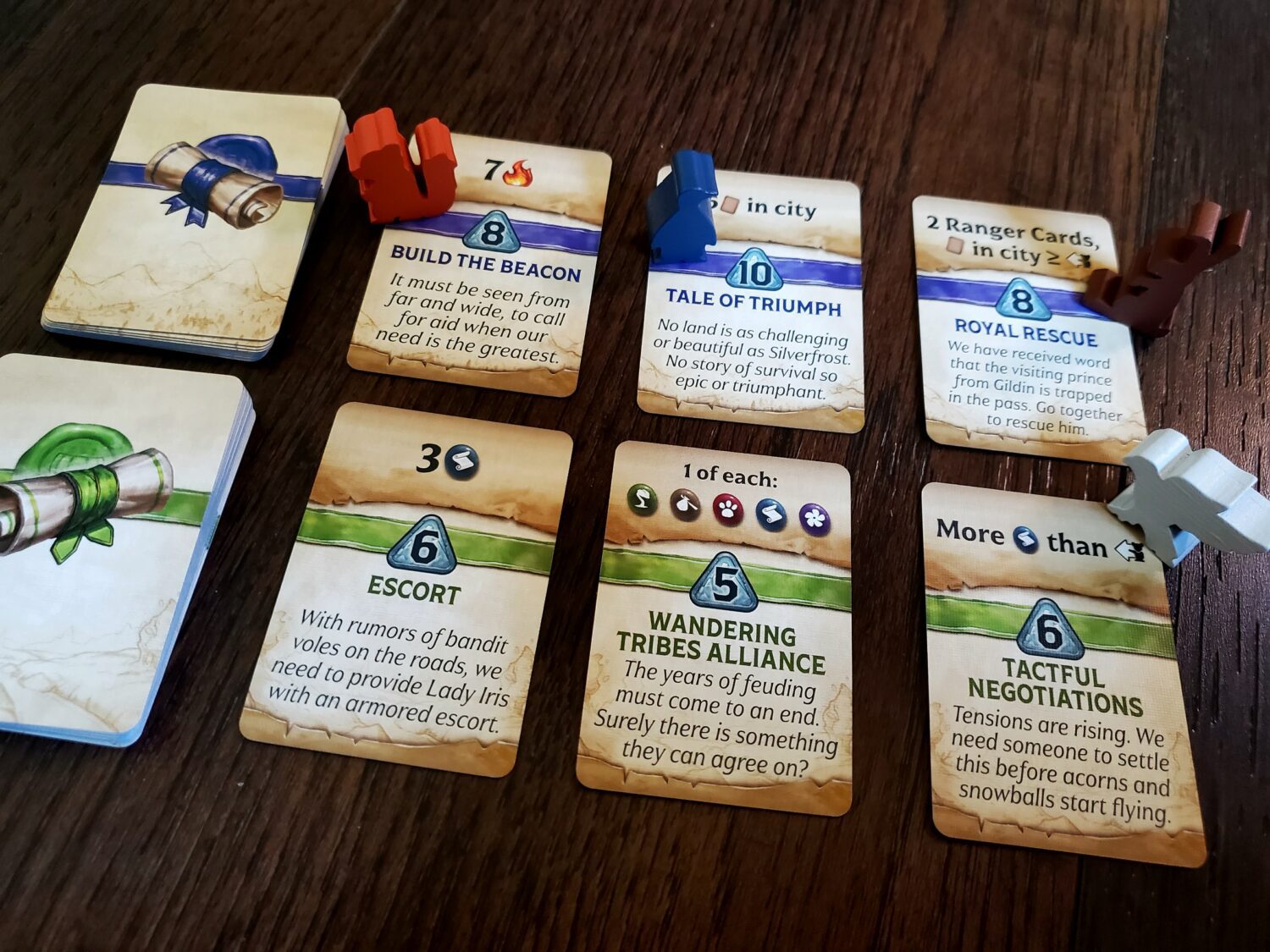
The Quests and the Guild location introduce a bit of a side game that feels new. Rather than simply seeking a long-term engine, it is now possible to score substantially by accomplishing fleeting moments— snapshots of advantage within the game that need only last long enough to prove it happened. Such moments might include having more of a certain card or resource than the player to your left. They are highly lucrative even if only temporary, so they keep players on their toes looking for opportunities. Truth be told, they aren’t much different than the old Events, they are just more varied and a bit more generous in their rewards.
On the surface, Silverfrost presents as a more interactive experience than other Everdell titles. Several card mechanics force attention to others’ cities and situations with a new icon pointing to a neighbor. I’m not sure it’s actually more interactive in play, but certainly more widely interactive in potential. There have always been cards that involved giving to others. The Events were always about racing or being ready for opportunity to knock, but here it’s perhaps a bit more pronounced. The game now requires and directly rewards attention to resources, cards, cities, and the like, whereas before it was only implied and strategically beneficial. I can get behind that shift. (Maybe a few extra Event-tiles-as-promos are in order for the base game?)
Dilemma
I’m not going to lie, Silverfrost’s winter is rough. This game fights back, and with a bitter cold fury. The cards you work so hard to build are rendered ineffective with extreme prejudice. The board locations, necessary to bear fruit, are cut off when you need them most. As much as Everdell has always been a place of whimsy, Silverfrost has grown up and apparently suffered some sort of emotional trauma that now manifests as revenge on any cute critter that wants to call the Valley home. Siegmon’s art has a slightly more serious tone, and fittingly so.
My daughter and I played the first game of Silverfrost. We have tackled every Everdell title together, and we were excited. We walked away a bit stunned. At the denouement, five of the eight Valley cards were snow covered, and we just didn’t have the fire to fight back, meaning we were mostly hamstrung and unable to explore cards. We were too worried about our own cities, which were on ice as well. My daughter had at least one fifteen-minute turn calculating possible ways to alleviate the pressure. In the end, one third of her cards didn’t score and she voiced disapproval. In a way, I can’t blame her because this title doesn’t feel like any of its predecessors. This is the most demanding iteration yet.
I wasn’t happy, either. But I also wasn’t finished. I came back for more, and here’s what I’ve found. Silverfrost is good. Really good. But it’s also not for everybody. I say that because though I’ve found something compelling in battling these elements, I don’t think Silverfrost is for me. I’m just not into the antagonism, even if it is admirably contrived.
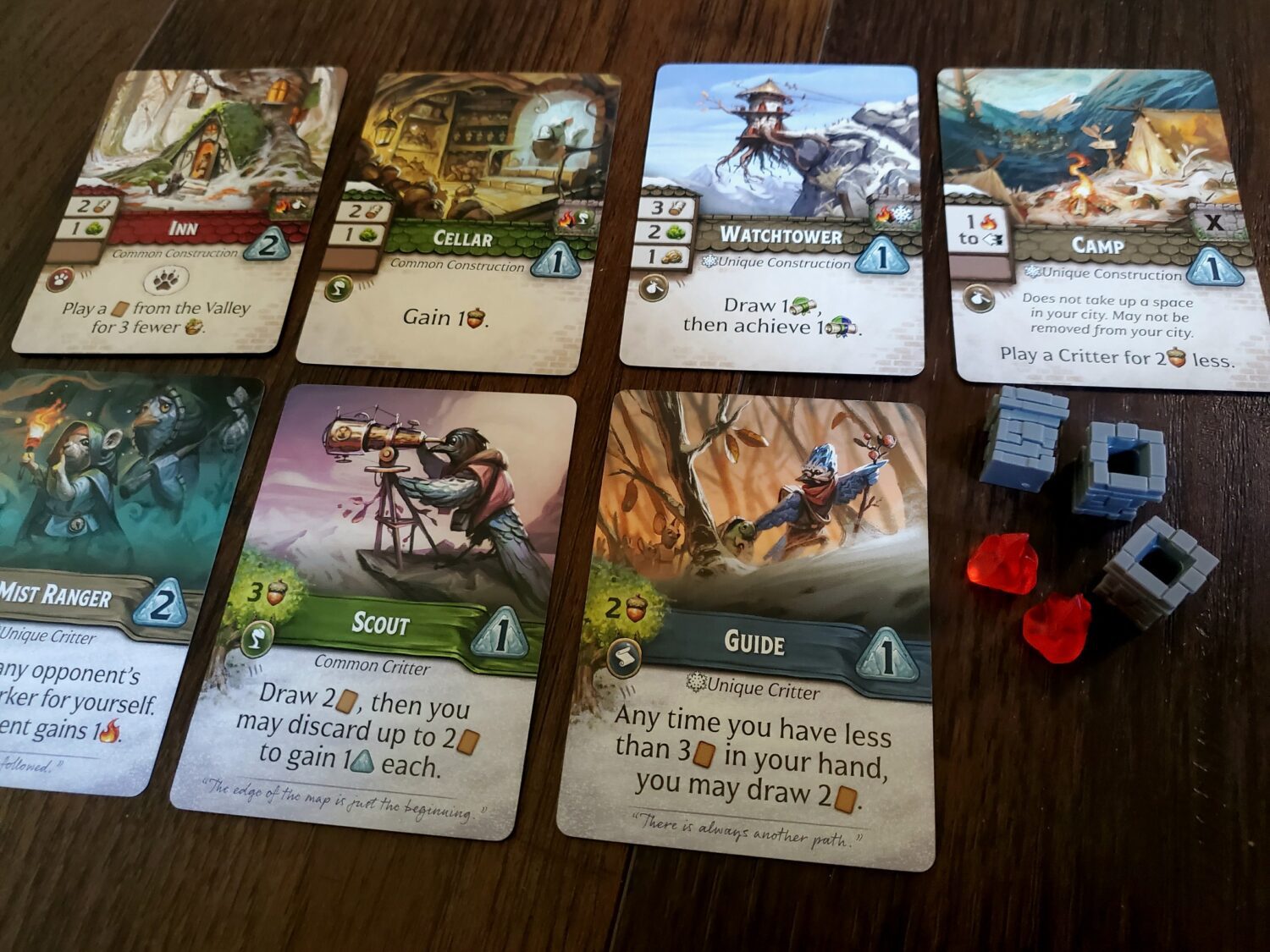
But I won’t let that stop me from praising its merits. The Kickstarter campaign promised that this is the most strategic Everdell yet. I must agree. Never before has every worker, every decision, felt so critical. You will absolutely find yourself calculating the order of tasks on every turn: when to remove snow, when to play a card, when to visit a beacon in order to keep the whole machine running.
As a result, turns here are longer. I’ve only played Silverfrost at two players, and every game has pushed two hours. Granted, we are “new” in a sense, but in another sense I’m not new at all, which says something. From the first game, despite utter familiarity with most of the cards, I was sucked into a level of forethought that has never beckoned before. I don’t think I’d jump in with four, or possibly even three, players.
In addition to forethought, there is a bit of agony here that some will absolutely adore. This game is punishing like an 80s karate movie villain. You know it’s coming, you just want to see it defeated. You want to fight back against the imposing threat and come out victorious. You want a clean city. You want to have fire left at the end to hit up the Journey for bonus points. No matter how many black eyes the game delivers, you want to slap a raw steak on it and come back again, stronger and with greater confidence.
I appreciate Silverfrost. I like to think I landed a few tournament points. I scored more with each subsequent play, chased new possibilities and found sweet combinations. But I prefer the whimsy and positivity of the original. I’m not sure I want an Everdell that’s out to get me, even though I can see the sheer brilliance of the battle at hand. If you like a game that comes at you with a bit of pluck, you will love this one.
Questioning Questions
After chatting with a friend about the experience, we were both wondering if there weren’t a few missed opportunities. We talked about asymmetric abilities for each of the character meeples. Maybe the hawks could avoid paying fire in the mountain, the penguins in the valley, etc. just to feel like the game offered some sympathy.
We also wondered about cooperative possibilities: perhaps a semi-cooperative cauldron in the middle where players could contribute to battling the elements together on the board? One of the greatest complaints against Everdell in the past has been the massive stack of cards and the likelihood of failing to see the cards and synergies that make the game sing. Seeing the Valley cards paralyzed without the means (or the will) to help was doubly frustrating. We finished that first game and then went through the deck to see the many, many cards that never surfaced. Admittedly, I was more intentional in subsequent plays, but knowing such a maddening possibility is in the design made us wish for a way to work together for the good of the experience.
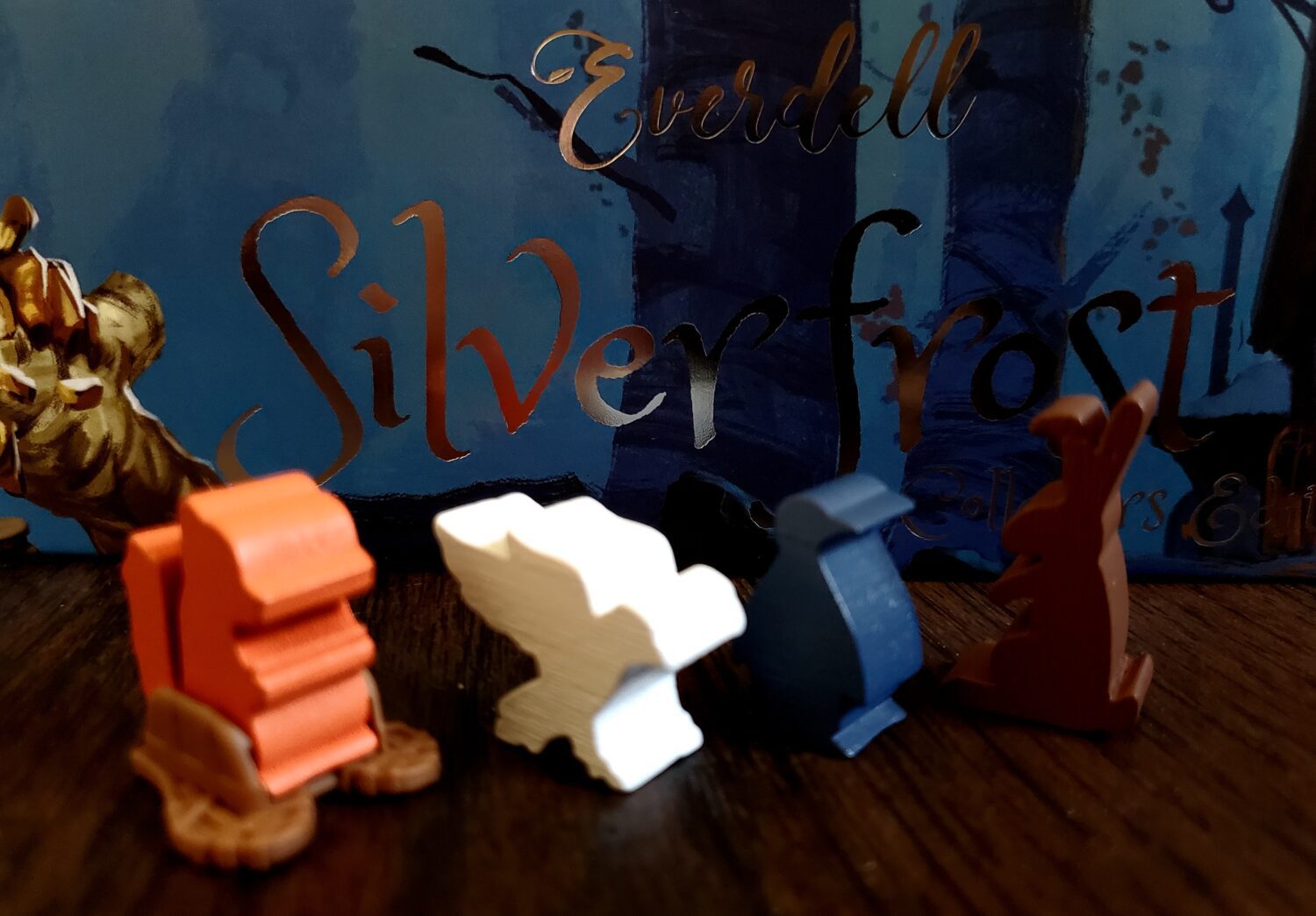
I also have a couple questions about the cards. There are a few that remind me of Pearlbrook’s wonders— so potent they cannot be ignored. Some of those purple Prosperity cards are insane. In a game where cards are worth one and two points, scoring 14 or 17 on a single card seems inflated (the Warden). Good for the player who seizes the moment, right? Along that same line, multiple cards that enable the reuse of a chimney means the possibility of hustling three Prosperity cards for free, provided the right constructions enter the picture.
Likewise some of the blue Governance cards offer potent abilities. The Guide draws two cards any time a player has less than three, encouraging discards, guaranteeing variety, and maintaining possibilities— if it appears at all. Another, the Sky Ranger, increases the hand size to ten and draws to the limit after a successful visit to the Guild. (Any familiar player can find the loop here that partners with the Journey in the final season.) Some of these little nuances make Silverfrost the sort of game that will be less forgiving to new players. Conversely, it is the game that rewards familiarity and sets seasoned players up for classic opportunistic battles.
Engage
Everdell Silverfrost feels like a conquest. Players leave the first session with a bruised kidney and a limp, but also with a bit of motivation to try again. If you love the tension of a game that actively resists your efforts at success, you might run towards it to feel the rush when the chips fall in your favor. If you don’t like feeling stifled by a board game— the default position in our household— you might run from this daunting mountain without an inkling to return. Even if I don’t think I’ll turn to the mountain forever, I am pretty thrilled at having figured out how to engage.
If you love laying out a tactical plan, there is no shortage here. If you love responding to ebbs and flows— new cards and disappearing cards, falling snow and suddenly cleared snow— then you will be thrilled to set out with these critters to test your mettle and your patience.
I will never turn down an Everdell title. It is only from a deep love of the original that I come armed with so many words, positive and negative. I am always happy to explore what James & Clarissa Wilson have created. I will hang on with this blustery beauty for as long as I can.


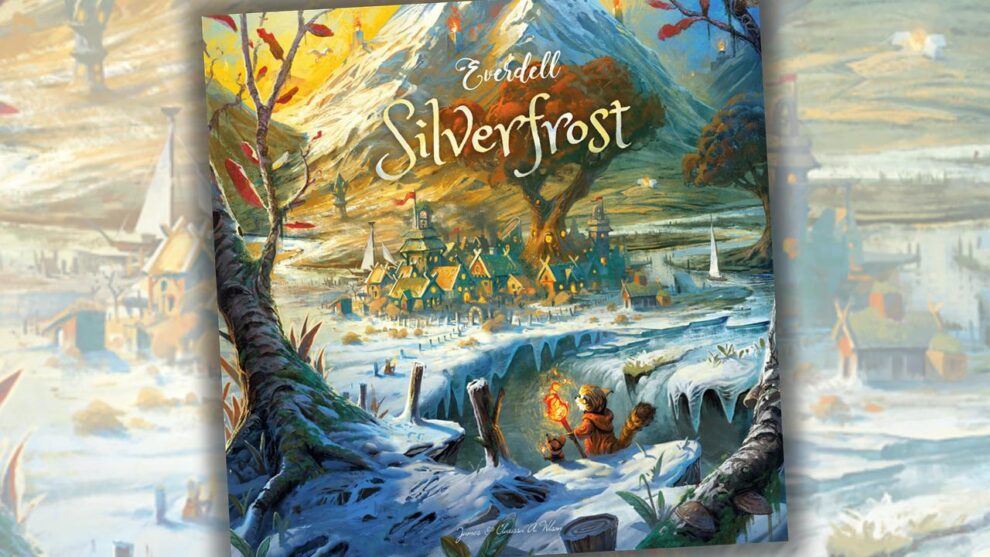
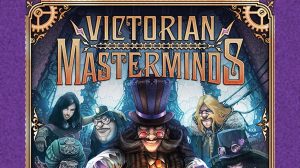







Beautifully written, sir. Although I think I enjoy this game more than you, I see and understand everything you have to say about it. Honest, critical, and loving: a combination not always easy to write.